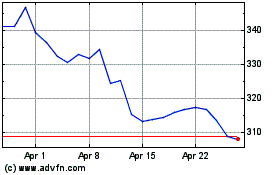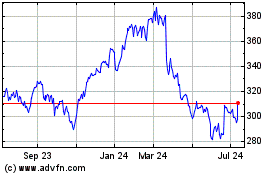Banks Could Increase Annual Revenues by Nearly 4% by Embracing Innovative Business Models of Digital-Only Players, Accenture Report Finds
November 09 2021 - 12:01AM
Business Wire
Banks have an opportunity to reap an additional
US$518 billion in revenues by 2025
By rethinking their business models and embracing the innovative
strategies of digital-only banking and financial services new
entrants, traditional banks could boost revenues by nearly 4%
annually, resulting in more than half a trillion dollars in
additional revenues by 2025, according to a new report from
Accenture (NYSE: ACN).
This press release features multimedia. View
the full release here:
https://www.businesswire.com/news/home/20211108006138/en/
Projected Banking Revenue Growth
(Graphic: Business Wire)
The report, “The Future of Banking: It’s time for a change of
perspective,” analyzes the business models of nearly 100 leading
traditional banks and over 200 digital-only players in 11 countries
across North America, Europe, Asia-Pacific, and Latin America and
the role they play in the banking value chain. It identified two
common business models:
- vertically integrated — traditional, linear business models,
i.e., those that sell only their own products, those that
distribute products from other providers, and those that deliver
technology or business processes to others; and
- non-linear — adaptive business models, i.e., “packagers” that
assemble new propositions, adding value beyond just distribution;
and firms that embed their propositions into third-party services,
such as “buy now, pay later” services embedded into the merchant
point-of-sale.
Many of the leading banks analyzed in the report have vertically
integrated business models. However, the report found those that
unbundle their traditional products and partner with third parties
to create and distribute new personalized customer offerings can
potentially achieve breakout growth and higher market valuations.
Specifically, by layering non-linear business models on top of the
traditional vertically integrated model, they could boost their
annual growth rates by up to an additional 3.8%, which would result
in US$518 billion in total additional revenues by 2025.
“On the surface, the banking industry appears healthy, with big
banks posting robust revenues and profits,” said Michael Abbott, a
senior managing director at Accenture who leads its Banking
industry group globally. “But a closer look reveals that the
combination of low interest rates, fee compression from increased
competition, and undifferentiated product offerings is slowly
eroding banks’ share of gross domestic product. And in many
markets, banking and payments revenues are flowing from incumbents
to new entrants. To re-ignite growth, traditional banks need to
reimagine how they create and deliver compelling products that
focus on customers’ intentions. That will require rethinking their
vertically integrated business models.”
The report notes that between 2018 and 2020, digital-only
players performed significantly better than traditional banks. But
those that adopted non-linear business models achieved 76% compound
annual growth rate (CAGR) in revenue, while those digital players
simply emulating traditional, vertically integrated models achieved
only 44% CAGR. Traditional banks in even the best-performing mature
markets grew revenue at an average rate of less than 2% annually –
albeit off a much larger base.
The report lists ways that traditional banks can leverage their
strengths — their balance sheet power, risk management expertise,
and regulatory savvy — to increase business model flexibility and
differentiate themselves from the competition. Specifically, they
should consider embracing one or a mix of the following models:
- Sell only products that the bank produces and control all
layers in the value chain, from manufacturing to distribution, with
a key value driver being the ability to consolidate via M&A and
take market share.
- Build a distribution-driven ecosystem, distributing banking and
financial products from other companies, and create a marketplace
to distribute non-banking products.
- Seek scale by delivering technology or business processes to
other companies.
- Create new propositions by building or bundling fragmented
products and services, which can be distributed by the bank or
third parties.
“Being digital is no longer a differentiator,” said Dilnisin
Bayel, a managing director in Accenture’s Strategy & Consulting
group in the U.K. “To capture growth, traditional banks need to go
beyond becoming the best digital versions of themselves and become
adept at operating multiple business models simultaneously. This
will require that they shift their perspective to consider adaptive
models that put product innovation, embedded distribution, purpose,
and sustainability at the forefront. Banks can choose to continue
to innovate at their current pace or take a fast-follower or leader
approach to business model transformation — but they can’t afford
to remain stagnant.”
The full report can be found here.
Accenture’s Banking industry group helps retail and commercial
banks and payments providers boost innovation; address business,
technology and regulatory challenges; and improve operational
performance to build trust and engagement with customers and grow
more profitably and securely. To learn more, visit
https://www.accenture.com/us-en/industries/banking-index.
Methodology The report, “The Future of Banking: It’s time
for a change of perspective,” is based on quantitative and
qualitative analysis of the business models of nearly 100 leading
incumbent banks (by size of total assets) and more than 210 new
banking and financial services entrants (defined by valuation,
funding, and revenues) in 11 countries, including Australia,
Brazil, Canada, China, France, Germany, Italy, Spain, the United
Arab Emirates, the U.S. and the U.K. The analysis was complemented
with data from the 2020 Accenture Banking Consumer Study and
interviews with banks, digital financial services providers,
industry analysts and investors.
About Accenture Accenture is a global professional
services company with leading capabilities in digital, cloud and
security. Combining unmatched experience and specialized skills
across more than 40 industries, we offer Strategy and Consulting,
Interactive, Technology and Operations services — all powered by
the world’s largest network of Advanced Technology and Intelligent
Operations centers. Our 624,000 people deliver on the promise of
technology and human ingenuity every day, serving clients in more
than 120 countries. We embrace the power of change to create value
and shared success for our clients, people, shareholders, partners
and communities. Visit us at www.accenture.com.
This content is provided for general information purposes and is
not intended to be used in place of consultation with our
professional advisors. This document refers to marks owned by third
parties. All such third-party marks are the property of their
respective owners. No sponsorship, endorsement or approval of this
content by the owners of such marks is intended, expressed or
implied.
View source
version on businesswire.com: https://www.businesswire.com/news/home/20211108006138/en/
Melissa Volin Accenture +1 267 216 1815
melissa.volin@accenture.com
Accenture (NYSE:ACN)
Historical Stock Chart
From Mar 2024 to Apr 2024

Accenture (NYSE:ACN)
Historical Stock Chart
From Apr 2023 to Apr 2024
